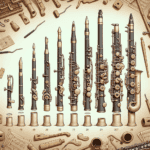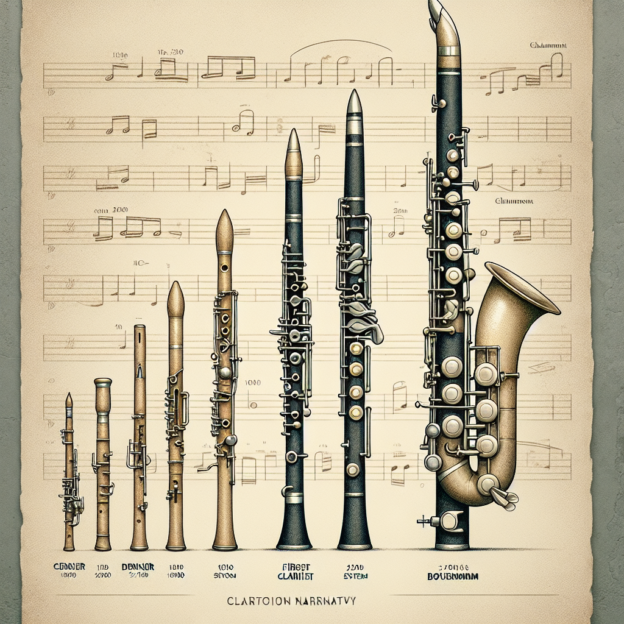Introduction to Clarinet Key Mechanisms
When we think of the clarinet, we often think about its beautiful sound and versatility across genres. However, behind that warm tone lies a clever design of precise key mechanisms that have evolved over centuries. Join us on a journey through time as we explore the key moments that have shaped the keywork of this beloved instrument!
Early Beginnings: The Chalumeau
The clarinet's story begins in the late 17th century, with its earliest versions being quite different from what we see today. The first clarinets, known as chalumeaus, had limited keys and were relatively simple in their construction. As musicians wanted to play more notes and express themselves better, they needed a more complex key mechanism.
18th Century Innovation: The First True Clarinet
Fast forward to the 18th century when Johann Christoph Denner created the first true clarinet in the early 1700s. This clarinet had an added register key that let musicians play higher notes, setting the stage for future improvements. Imagine how exciting this must have been for musicians back then! It was like getting a brand new tool to make music with.
| Century | Key Innovation | Impact |
|---|---|---|
| 17th | Chalumeau (early clarinet) | Limited keys, simple construction |
| 18th | First true clarinet by Denner | Added register key for higher notes |
| 19th | Boehm system | Improved ergonomics and finger positions |
| 20th | Modern clarinet | 17 keys, additional mechanisms for better control |
19th Century Advancements: The Boehm System
In the 19th century, key mechanism design really improved. The Boehm system, created by Theobald Boehm, was a big step forward. This system made the layout more comfortable to play and improved finger positions, which made playing easier and smoother. Key mechanisms were made to be more precise and responsive. This was a huge improvement, letting players perform fast passages easily while keeping good sound quality.
Material Evolution: From Wood to Metal
But it wasn't just about making playing easier. The materials used for the key mechanisms also changed. Clarinets started using metal keys instead of wood, which made them last longer and look better. Using metal for the keys allowed for more precise adjustments and reliable performance. It's important to mention that the Martin Freres brand played a big role in making sure these key mechanisms were top quality. They knew that using the right materials could really improve how musicians played worldwide.
20th Century Developments: Modern Clarinet Features
As we entered the 20th century, clarinet keywork kept improving with more keys added for better control over pitch and dynamics. Today's clarinet usually has 17 keys and other mechanisms like side keys, which let players use different fingerings and improve tuning. These improvements took years of trying new things and making them better; each new model tries to make it possible to play even more expressively.
The Importance of Maintenance
Of course, with all these improvements, taking good care of the instrument became really important. Making sure all the screws, springs, and pads work well helps your instrument last longer and sound better. It's a good idea to check your clarinet regularly—this can save you a lot of trouble later on!
Playing Style and Personal Preference
An interesting thing about clarinet key mechanisms is how they relate to how people play and what they like. Each player might adjust their mouthpiece and setup differently, needing the keys to respond in different ways. This is where brands like Martin Freres do a great job, making clarinets for all kinds of players from beginners to professionals, with different likes and needs.
Conclusion: A Journey of Innovation
To sum up, the way clarinet key mechanisms have changed over time shows how instrument design keeps improving and adapting. The change from the simple chalumeau to the complex modern clarinet represents centuries of skilled craftsmanship and clever ideas. These mechanisms not only make the sound better but also greatly affect how expressive the performance can be. Next time you play your clarinet, think about the amazing history behind those keys! Musical instruments have come such a long way, and we're still part of that ongoing discovery. Enjoy your playing!
Table of Contents
- Introduction to Clarinet Key Mechanisms
- Early Beginnings: The Chalumeau
- 18th Century Innovation: The First True Clarinet
- 19th Century Advancements: The Boehm System
- Material Evolution: From Wood to Metal
- 20th Century Developments: Modern Clarinet Features
- The Importance of Maintenance
- Playing Style and Personal Preference
- Conclusion: A Journey of Innovation







